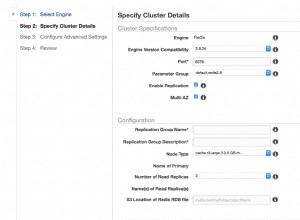Il framework di aggregazione è decisamente l'approccio giusto:tutto ciò che richiede JS sul server è un problema di prestazioni, mentre le aggregazioni vengono eseguite tutte nel server in codice nativo.
Sebbene sia possibile trasformare il compleanno in date di compleanni imminenti e quindi eseguire una query di intervallo, preferisco farlo in un modo leggermente diverso da solo.
L'unico "prerequisito è calcolare il giorno dell'anno di oggi". Esistono modi per farlo in varie lingue, quindi è possibile farlo nel livello dell'applicazione prima di chiamare l'aggregazione, passandogli questo numero. Stavo per chiamare il mio todayDayOfYear ma mi sono reso conto che puoi lasciare che il framework di aggregazione lo capisca in base a oggi, quindi l'unica variabile sarà la data odierna.
var today=new Date();
Presumo che un documento che includa il nome e la data di nascita, si aggiusti in modo appropriato per le variazioni
var p1 = { "$project" : {
"_id" : 0,
"name" : 1,
"birthday" : 1,
"todayDayOfYear" : { "$dayOfYear" : today },
"dayOfYear" : { "$dayOfYear" : "$birthday"}
} };
Ora, proietta quanti giorni da oggi fino al loro prossimo compleanno:
var p2 = { "$project" : {
"name" : 1,
"birthday" : 1,
"daysTillBirthday" : { "$subtract" : [
{ "$add" : [
"$dayOfYear",
{ "$cond" : [{"$lt":["$dayOfYear","$todayDayOfYear"]},365,0 ] }
] },
"$todayDayOfYear"
] }
} };
Escludi tutti tranne quelli nell'intervallo desiderato:
var m = { "$match" : { "daysTillBirthday" : { "$lt" : 31 } } };
Ora esegui l'aggregazione con:
db.collection.aggregate( p1, p2, m );
per ottenere un elenco di nomi, compleanni e giorni fino al compleanno per tutti i fortunati il cui compleanno è entro 30 giorni.
MODIFICA
@Sean999 ha catturato un caso limite interessante:le persone nate in un anno bisestile dopo il 28 febbraio avranno uno scarto di uno. Quella che segue è un'aggregazione che si adatta correttamente a questo:
var p1 = { "$project" : {
"_id" : 0,
"name" : 1,
"birthday" : 1,
"todayDayOfYear" : { "$dayOfYear" : ISODate("2014-03-09T12:30:51.515Z") },
"leap" : { "$or" : [
{ "$eq" : [ 0, { "$mod" : [ { "$year" : "$birthday" }, 400 ] } ] },
{ "$and" : [
{ "$eq" : [ 0, { "$mod" : [ { "$year" : "$birthday" }, 4 ] } ] },
{ "$ne" : [ 0, { "$mod" : [ { "$year" : "$birthday" }, 100 ] } ] } ] } ] },
"dayOfYear" : { "$dayOfYear" : "$birthday" } } };
var p1p = { "$project" : {
"name" : 1,
"birthday" : 1,
"todayDayOfYear" : 1,
"dayOfYear" : { "$subtract" : [
"$dayOfYear",
{ "$cond" : [ { "$and" : [ "$leap", { "$gt" : [ "$dayOfYear", 59 ] } ] }, 1, 0 ] } ] }
}
}
p2 e m rimanere come sopra.
Input di prova:
db.birthdays.find({},{name:1,birthday:1,_id:0})
{ "name" : "Ally", "birthday" : ISODate("1975-06-12T00:00:00Z") }
{ "name" : "Ben", "birthday" : ISODate("1968-04-03T00:00:00Z") }
{ "name" : "Mark", "birthday" : ISODate("1949-12-23T00:00:00Z") }
{ "name" : "Paul", "birthday" : ISODate("2014-03-04T15:59:05.374Z") }
{ "name" : "Paul", "birthday" : ISODate("2011-02-07T00:00:00Z") }
{ "name" : "Sean", "birthday" : ISODate("2004-01-31T00:00:00Z") }
{ "name" : "Tim", "birthday" : ISODate("2008-02-28T00:00:00Z") }
{ "name" : "Sandy", "birthday" : ISODate("2005-01-31T00:00:00Z") }
{ "name" : "Toni", "birthday" : ISODate("2009-02-28T00:00:00Z") }
{ "name" : "Sam", "birthday" : ISODate("2005-03-31T00:00:00Z") }
{ "name" : "Max", "birthday" : ISODate("2004-03-31T00:00:00Z") }
{ "name" : "Jen", "birthday" : ISODate("1971-04-03T00:00:00Z") }
{ "name" : "Ellen", "birthday" : ISODate("1996-02-28T00:00:00Z") }
{ "name" : "Fanny", "birthday" : ISODate("1996-02-29T00:00:00Z") }
{ "name" : "Gene", "birthday" : ISODate("1996-03-01T00:00:00Z") }
{ "name" : "Edgar", "birthday" : ISODate("1997-02-28T00:00:00Z") }
{ "name" : "George", "birthday" : ISODate("1997-03-01T00:00:00Z") }
Uscita:
db.birthdays.aggregate( p1, p1p, p2, {$sort:{daysTillBirthday:1}});
{ "name" : "Sam", "birthday" : ISODate("2005-03-31T00:00:00Z"), "daysTillBirthday" : 22 }
{ "name" : "Max", "birthday" : ISODate("2004-03-31T00:00:00Z"), "daysTillBirthday" : 22 }
{ "name" : "Ben", "birthday" : ISODate("1968-04-03T00:00:00Z"), "daysTillBirthday" : 25 }
{ "name" : "Jen", "birthday" : ISODate("1971-04-03T00:00:00Z"), "daysTillBirthday" : 25 }
{ "name" : "Ally", "birthday" : ISODate("1975-06-12T00:00:00Z"), "daysTillBirthday" : 95 }
{ "name" : "Mark", "birthday" : ISODate("1949-12-23T00:00:00Z"), "daysTillBirthday" : 289 }
{ "name" : "Sean", "birthday" : ISODate("2004-01-31T00:00:00Z"), "daysTillBirthday" : 328 }
{ "name" : "Sandy", "birthday" : ISODate("2005-01-31T00:00:00Z"), "daysTillBirthday" : 328 }
{ "name" : "Paul", "birthday" : ISODate("2011-02-07T00:00:00Z"), "daysTillBirthday" : 335 }
{ "name" : "Tim", "birthday" : ISODate("2008-02-28T00:00:00Z"), "daysTillBirthday" : 356 }
{ "name" : "Toni", "birthday" : ISODate("2009-02-28T00:00:00Z"), "daysTillBirthday" : 356 }
{ "name" : "Ellen", "birthday" : ISODate("1996-02-28T00:00:00Z"), "daysTillBirthday" : 356 }
{ "name" : "Fanny", "birthday" : ISODate("1996-02-29T00:00:00Z"), "daysTillBirthday" : 356 }
{ "name" : "Edgar", "birthday" : ISODate("1997-02-28T00:00:00Z"), "daysTillBirthday" : 356 }
{ "name" : "Gene", "birthday" : ISODate("1996-03-01T00:00:00Z"), "daysTillBirthday" : 357 }
{ "name" : "George", "birthday" : ISODate("1997-03-01T00:00:00Z"), "daysTillBirthday" : 357 }
{ "name" : "Paul", "birthday" : ISODate("2014-03-04T15:59:05.374Z"), "daysTillBirthday" : 360 }
Puoi vedere che le persone con lo stesso compleanno ora hanno lo stesso numero di giorni fino al compleanno, indipendentemente dal fatto che siano nate in un anno bisestile o meno. Ora è possibile eseguire il passaggio di corrispondenza per il taglio progettato.
MODIFICA
A partire dalla versione 3.5.11 ci sono diverse espressioni di manipolazione della data nella pipeline di aggregazione che lo rendono notevolmente più semplice da scrivere. In particolare, l'espressione $dateFromParts permette di costruire una data da varie parti, consentendo questa aggregazione:
var today = new Date();
var a1 = {$addFields:{
today:{$dateFromParts:{year:{$year:today},month:{$month:today},day:{$dayOfMonth:today}}},
birthdayThisYear:{$dateFromParts:{year:{$year:today}, month:{$month:"$birthday"}, day:{$dayOfMonth:"$birthday"}}},
birthdayNextYear:{$dateFromParts:{year:{$add:[1,{$year:today}]}, month:{$month:"$birthday"}, day:{$dayOfMonth:"$birthday"}}}
}};
var a2 = {$addFields:{
nextBirthday:{$cond:[ {$gte:[ "$birthdayThisYear", "$today"]}, "$birthdayThisYear", "$birthdayNextYear"]}
}};
var p1 = {$project:{
name:1,
birthday:1,
daysTillNextBirthday:{$divide:[
{$subtract:["$nextBirthday", "$today"]},
24*60*60*1000 /* milliseconds in a day */
]},
_id:0
}};
var s1 = {$sort:{daysTillNextBirthday:1}};
db.birthdays.aggregate([ a1, a2, p1, s1 ]);
Puoi impostare "oggi" su qualsiasi data (anno bisestile o meno) e vedere che il calcolo ora è sempre corretto e molto più semplice.




